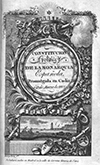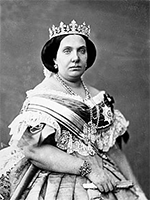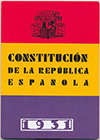Spain has had a number of constitutions through the years. The first was in the early 19th Century, and the current one dates to the late 20th Century.
As the 19th Century began, France was at war with many other European powers. Spain at that time was an ally of sorts. However, the French Emperor Napoleon Bonaparte eventually decided that he wanted a familiar face on the Spanish throne and so, in 1808, demanded the abdication of Spain's then-current monarch, Charles IV, and, eventually as well, his son, Ferdinand VII. The new King of Spain was Joseph Bonaparte, Napoleon's brother.
Bayonne Statute
To solidify this new rule, Emperor Bonaparte directed one of his top generals, Joachim Murat, to hammer out an agreement with powerful Spanish nobles. The result was the Bayonne Statute, also called the Bayonne Constitution (Bayonne being the place in France at which occurred the meetings, including the one in which the two kings abdicated). Along the lines of France's most recent multi-layered government, the Bayonne government was to have a three-part government, consisting of a legislature, a large number of government ministers, and an independent judiciary. Catholicism was declared the state religion; the constitution guaranteed other individual liberties. As well, the Philippines and areas in the New World still controlled by Spain won the right to representation in the new government.
Constitution of 1812
 The first Spanish constitution to have that word in its title was the Spanish Constitution of 1812. An update to the Bayonne Statute, this constitution guaranteed representation in the legislature from all around the country. (Only a third of the nobles had attended the meeting in Bayonne in 1808.) Significantly, this constitution provided for universal male suffrage (not including any requirement to own property, as had been the case), freedom of the press, freedom of business enterprise, and freedom from the dominance of corporate privileges known as fueros. Also significantly, this constitution put the real power of governing in the hands of a parliament, to which the monarch would answer on certain questions or actions; that parliament would meet annually in Madrid.
The first Spanish constitution to have that word in its title was the Spanish Constitution of 1812. An update to the Bayonne Statute, this constitution guaranteed representation in the legislature from all around the country. (Only a third of the nobles had attended the meeting in Bayonne in 1808.) Significantly, this constitution provided for universal male suffrage (not including any requirement to own property, as had been the case), freedom of the press, freedom of business enterprise, and freedom from the dominance of corporate privileges known as fueros. Also significantly, this constitution put the real power of governing in the hands of a parliament, to which the monarch would answer on certain questions or actions; that parliament would meet annually in Madrid.
Focusing on the vestiges of the once broad Spanish Empire, the Constitution of 1812 granted indigenous people living in Spanish-controlled New World lands (such as the Viceroyalty of New Spain and the Viceroyalty of Peru) full Spanish citizenship. The glaring exception to this was enslaved people, who continued to have few rights.
This constitution was also known as the Constitution of Cádiz because it had the solid support of the Cortes of Cádiz, a new form of the parliament-equivalent cortes, which had not been in operation for awhile.
Technically, from 1812, Joseph Bonaparte was a constitutional monarch. When he fled the country in the wake of a series of victories by a joint British-Portuguese force, Ferdinand VII filled the vacuum and claimed the throne again, in 1814. He refused to acknowledge the constitution or its parliament and, with the backing of the army and some powerful nobles, ruled as an absolute monarch.
A mutiny of troops in 1820 sparked a wider revolt that succeeded in taking King Ferdinand prisoner. Thus distracted, the king could only receive reports from abroad as one by one of his overseas possessions gained their freedom. Ferdinand was technically still king, but his people had taken away his mystique and, technically, his right to dictate terms.
Into Spain's internal fray in 1823 came a French army, sent by that country's king, Louis XVIII, to try to restore Ferdinand's absolutism. He and they were successful, the rebel force releasing the king after the French victory in the Battle of Trocadero. Ferdinand remained the sole governmental authority until his death, in 1830.

His designated successor was, controversially, his 3-year-old daughter, Isabella. While her mother, Queen Maria Christina, served as regent, a sizable part of the population rose up in revolt, sparking the first of three Carlist Wars, named after Carlos, the Count of Medina, who was Ferdinand's younger brother and thought his a better case for succession than that of young Isabella.
Constitution of 1837
During that war came a new governmental blueprint, the Constitution of 1837. This document called for a two-house parliament: a lower house chosen by popular vote and an upper house chosen by the monarch. Gone was universal male suffrage, replaced by a system that favored those who had more money. Another constitution, eight years later, restricted suffrage even further.
Isabella II came of age to rule in her own right in 1843 and spent the next two decades, for the most part, struggling for legitimacy. By 1868, a majority of people had had enough of the chaos–the wars of succession, the military coups, the adoptions and then setting aside of a very new constitution, the switching of sides between conservative and liberal depending on what seemed like royal whims–and whims they were because the longer her reign extended, the more she became an autocrat. On September 18, a large number of varying factions combined efforts to overthrow the queen, in what many sources refer to as the Glorious Revolution. She fled to France.
Constitution of 1876
Amadeo ruled for two years and then abdicated, in the wake of the declaration of the First Spanish Republic. Three years after that, Spain had another new monarch, Alfonso XII. To cement his status as a consitutional monarch, a group of nobles again got together and again approved a new governmental blueprint, the Constitution of 1876. The king and parliament shared legislative powers. The king had the power to appoint ministers, without needing parliamentary approval. In fact, the king had the power to suspend or even dissolve the Cortes. As well, this constitution brought a return of the establishment of Catholicism as the state religion and the public worship of other faiths punishable. Initially, the Constitution of 1876 provided for election of parliament by census suffrage, whereby those who had more power had effectively more votes; in the 1890s, however, parliament re-established universal male suffrage.
In 1923, Spanish General Miguel Primo de Rivera launched a coup and declared himself a dictator. The king, Alfonso XIII, approved of the move, and Rivera was in charge until 1930. Public opinion of the dictatorship and the king's support for it waned. Alfonso XIII became highly unpopular and, after a disastrous showing in the 1931 elections, agreed to leave the country, in favor of the founding of the Second Spanish Republic.
Constitution of 1931
 To solidify the Republic, prominent Spaniards crafted the Constitution of 1931, which blazed a new trail for rights and privileges. Back in favor was freedom of religion. One significant change was in the realm of land ownership: The government could claim private property in the name of the Republic as long as it compensated the property owner for the loss. For the first time, women could vote. Elections were all the rage, determining who was the head of state (termed the President), the members of the parliament, and even the judiciary. Heading the executive branch was the Prime Minister, whom the President appointed.
To solidify the Republic, prominent Spaniards crafted the Constitution of 1931, which blazed a new trail for rights and privileges. Back in favor was freedom of religion. One significant change was in the realm of land ownership: The government could claim private property in the name of the Republic as long as it compensated the property owner for the loss. For the first time, women could vote. Elections were all the rage, determining who was the head of state (termed the President), the members of the parliament, and even the judiciary. Heading the executive branch was the Prime Minister, whom the President appointed.
This constitution was still on the books as the country descended into the Civil War. The victorious Nationalists repealed the Constitution of 1931 in 1939. After that war, Francisco Franco ruled as a dictator for more than 30 years. He died in 1975.